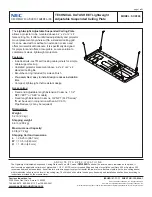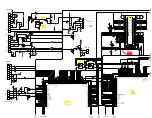
7
Recommended Maximum Cable Lengths
Models
Wire Size
Distance
mm
2
AWG
meters
feet
-1 (115 VAC)
1.5
16
1200
4000
2.5
14
1700
5700
4
12
3000
10,000
-2 (24 VAC)
0.5
22
45
150
-2X (24 VAC)
0.5
20
75
250
1
18
120
400
1.5
16
200
700
2,5
14
330
1100
-4 (230 VAC)
1.5
16
2000
6600
2.5
14
3200
10,500
4
12
5280
17,350
1.
Use the left liquid-tight fitting of the housing to route the power wire
into the housing. See Figure 9.
Figure 9: Liquid-Tight Fittings and Power Connector
(Side & Top Views)
2.
A screw/terminal lug is provided for securing a safety
ground. To attach the safety grounding wire (green
115 volt, green/yellow 230 volt), first unscrew the
terminal lug and strip and crimp the grounding wire into
the lug. Next pull the grounding wire through the larger
rear hole and attach the terminal lug to the cradle using
the M4 x 10 screw provided. See Figure 10.
Cradle
Large
Rear
Hole
Safety
Grounding
Wire
Terminal Lug
M4 Screw
S925A15AE
Figure 10: Securing Ground Wire
3.
Pull any excess wire out of the cradle assembly and
tighten the fitting to 8.5 N-m to 9.0 N-m (75 in-lb to
80 in-lb). This torque rating is approximately 1 to 1 1/2
turns past the point the fitting starts to grip the wire.
Failure to do so will allow water to enter and damage all
electronic parts. Use a tie wrap (included) to provide
strain relief on the power cord at the exit point (inside
unit). See Figures 17 and 18 for an example.
Be sure to securely tighten all fittings to
ensure a liquid-tight seal. Failure to do so
could allow water to enter the housing
and damage the camera and lens.
5.6.4
LTC 9383/60, LTC 9388/60 Housings
These housings require connection to 115 VAC, and are
designed to be used where site power is 115 volts.
The LTC 9383/60 and LTC 9388/60 housings can easily be
used with either 115 volt or 24 volt cameras.
The internal transformer provides 24 VAC for both the
heater/defogger and 24 volt camera power. The
transformer will provide flying leads for connection to the
primary (white wire/pin 1, black wire/pin 6) and the
secondary (white/black striped wires-pins 7 and 12). The
housing is shipped with the heater/defogger
connected to the secondary. No installer interface is
required. See Figure 9.
Installing a 115 volt camera into the LTC 9383/60 or
LTC 9388/60 housing requires the camera's line cord to be
cut and connected with the transformer primary leads and
the power supply line. See Figure 11.
1.
Cut the power cord leaving enough cable to allow
connection to the primary (approximately 5 inches).
Strip no less than 6 mm (0.25 in) and no more than
8 mm (0.31 in) of insulation away from the wire, be sure
not to nick the wires. Connect the supply line to the
camera power cord and transformer primary leads. Use
the wire nuts provided for this connection.
2.
The secondary flying leads (white/black striped) will not
be used in this application and should be taped to
prevent shorting. See wiring diagram Figure 11 for
clarification and Figure 9 for power connection
drawings.
To Heater/Defogger
Red
Red
To Heater/Defogger
To Camera
To Camera
24 VAC
115 VAC
Input
Black
White
S925A10AE
White/Black
Striped
No Connection
White/Black
Striped
Figure 11: LTC 9383/60/LTC 9388/60 Transformer
Wired for 115 Volt Camera
Installing a 24 volt camera into the LTC 9383/601 or
LTC 9388/60 housing utilizes the internal transformer for
camera power. See Figure 11.
1.
Connect the supply (115 VAC) to the primary flying
leads of the transformer (white wire/pin 1, black
wire/pin 6). Use the wire nuts provided for this
connection.
2.
Connect the secondary flying leads (white/black striped
wires-pins 7 and 12) to the camera's 24 volt input. See
wiring diagram Figure 12 for clarification and Figure 9
for power connection drawings.


































